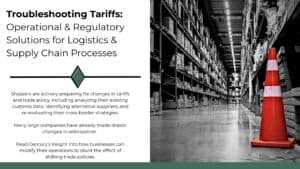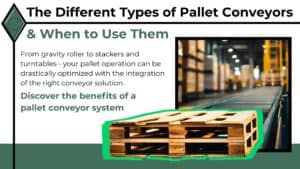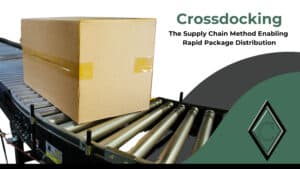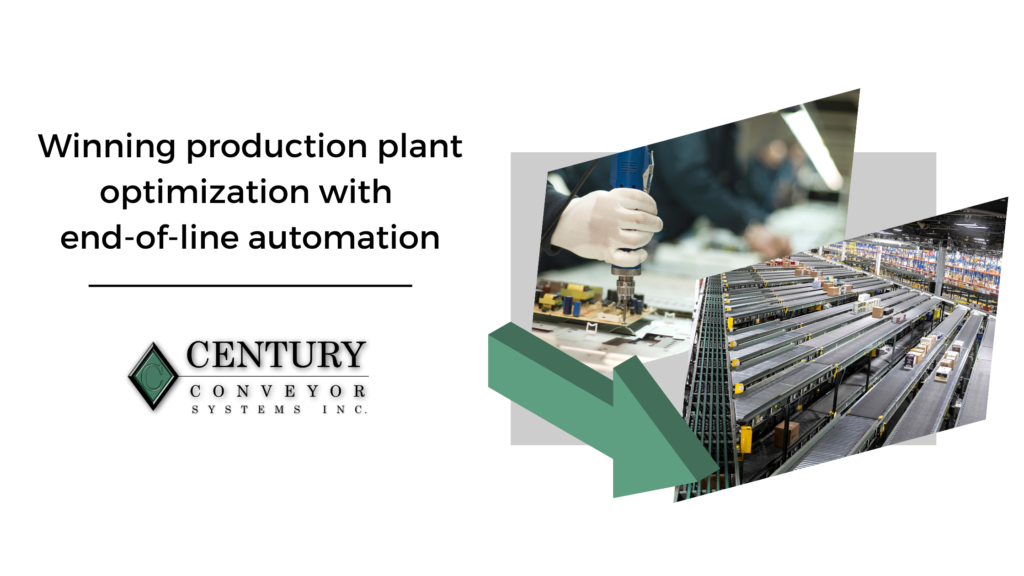
If you’re reading this, you’re most likely researching solutions to optimize your production plant for continuous improvement efforts. As the name implies, continuous improvement is continuous-it’s an ongoing effort to make your manufacturing facility a production powerhouse.
But consider this. Once the product is made, improvements simply don’t stop. End-of-line post-production optimizations can make or break the overall efficiency of a plant. A product can be manufactured perfectly, but if it’s not getting to your customers effectively, then your optimizations are a moot point. Flexible automation in the form of post-production systems like conveyors, warehouse robots, pick modules, palletizing arms, and more can revolutionize your end-of-line operations and benefit the entirety of your manufacturing lines.
If downstream processes haven’t been something you’ve looked at optimizing, or are currently searching for solutions, then keep reading. As a top post-production automation integrator for over 40 years; Century Conveyor Systems has extensive experience in implementing post-production systems for manufacturers who want the best out of their facility. Here’s a case study for a system we engineered for F. Schumacher Co.
Define Production vs Post-Production
Analyze and understand the transition your process line takes from production to post-production. Once the product is finished, where does it go? Is it packaged and palletized, then stored? Or, are individual items stored in a picking module for later fulfillment?
Regardless of your current operations, output in this transitory section should be engineered consistently. Overproduction is a very real source of waste (a tenet of lean manufacturing), and exceeding capacity when demand ebbs and flows, or when distribution systems can’t match production signifies an area of plant optimization.
If you notice this discrepancy, understand that post-production automation can be fine-tuned to keep items moving steadily. Modern conveyor systems can be engineered on the fly to output at certain speeds. Doing so can keep items moving to an automatic palletizer (and stretch wrap) for storage, or continue to EOL operations- instead of a static staging area that has to be manually transported and stored.
Product Handling Optimization
Depending on what your plant produces, the speed benefits of a conveyor or palletizing robot may seem unnecessary if it’s not a high-demand product, or if it’s a non-conveyable (oversized) item.
The secondary benefit of automation is the elimination of manual operations. While the output rate might not be feasible for your manufacturing plant, the cost-savings, stability, and flexibility may provide an effective optimization point.
Installing an automated system can be a significant upfront cost, but the long-term savings from removing the prior material handling processes (like forklifts, associated labor, and manual operations), can certainly result in a positive return on investment.
Material handling integrators or your internal team of plant managers and engineers can take advantage of the dynamic nature of automation systems. Don’t have the warehouse space or budget to install a conveyor system? Consider deploying an AGV or AMR to automatically transport pallets, cartons, or large items to where it needs to be. These automated warehouse robots are typically battery-operated, come in various sizes, and use sensors to navigate.
Regardless of the automation solution used, product handling optimization can be achieved via a multitude of specialized systems.
Output (Current and Planned)
Consider what products your plant currently manufactures. What are the fluctuations in demand? Is one specific product line experiencing an increase in sales? It’s important to understand the changes in product output according to your customer base.
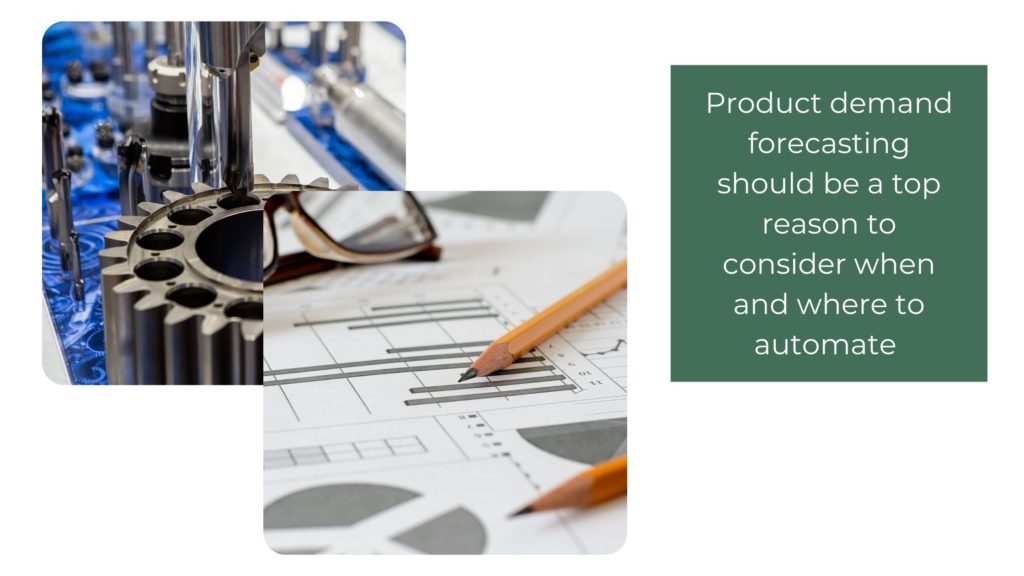
Implementing post-production automation doesn’t have to be a complete overhaul of your current EOL process. Gradual automation integration is absolutely an option, and adding a system where needed is an excellent avenue for optimization without breaking the bank. This helps avoid bottlenecks between production and distribution.
Coordinate with your R&D and purchasing department. If a new product is being conceptualized, what’s the estimated sales forecast for once it’s been launched? You may have multiple production lines in your plant, but different output rates depending on what’s being manufactured. In this case, consider automation for the top-producing line, then build upon the others once more budget can be allocated.
Storage or Processing?
Post-production automation isn’t just limited to distribution operations. Storage modules can be automated as well, for picking and putting.
An ASRS (automated storage and retrieval system) is a racking structure that employs a track-guided crane to store and retrieve (as the name suggests) pallets to and from rack compartments. A single employee can command the crane to pick a specific pallet from the terminal, which it will deposit in a receptacle that can link up with an in-feeding conveyor, or a staging area for transport.
Not every plant may have enough in-and-out going pallets to justify an ASRS. In the event that your manufacturing facility has a large catalog of products it creates, a shuttle system operates much the same, but on a SKU scale. Shuttle systems employ automated platforms that navigate within a racking structure to collect items for order fulfillment. Manufacturers that have large items probably won’t consider a shuttle system, but for a facility that has many different product variants, a shuttle system can be a powerful asset.
Interested in an ASRS or shuttle system? Read more about their benefits and functions on our Pick Modules and Storage Systems page.
Communication
As cliché as it sounds, communication is key in a manufacturing plant, yet, it’s something that’s often overlooked. Workers across your entire plant should be acutely aware of alerts that directly impact their section. Communication is not just simply speaking to one another, but as a transom of information. Many downtime situations or bottlenecks can be avoided by maximizing visibility between production and post-production.
Equipping warehouse workers with wearable technology like tablets, headsets, and scanners can keep constant communication channels open. Combine these terminals with a WMS (warehouse management system), and workers can see operating schedules, machine status, pending orders, and more from a single platform.
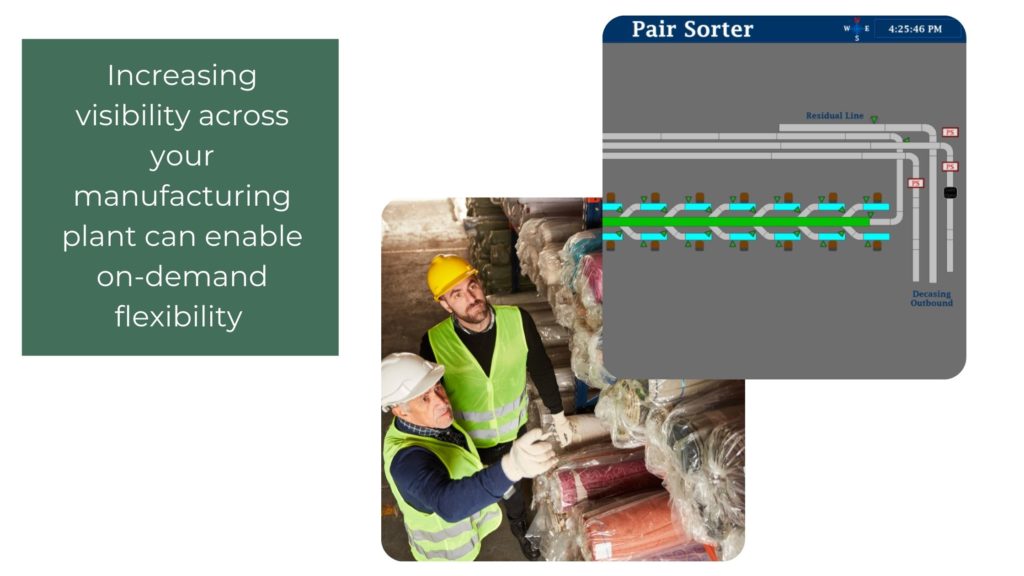
You may already have a management system in place, but you can increase visibility even further by implementing system-specific WCS (warehouse control systems) platforms.
For example, a production machine has been taken offline for maintenance. A worker downstream can then access the WCS portal and adjust the settings on an in-feeding conveyor system remotely to accommodate the reduced rate of production.
Overall Efficiency
Your post-production process doesn’t live in a bubble separate from manufacturing. Optimizing downstream systems impacts overall efficiency criteria, like:
- Order cycle time
- Correct product yield
- Changeover time
- On time and full
Returns can also be another gauging point, but not every production facility manages them. Depending on what your plant does with returns, integrating a re-commerce process can significantly decrease the amount of time it takes to exchange the product and fulfill the new order. If you work with a considerable number of returns, ensure a proper order management system is in place to keep track of anything that’s sent back.
For reporting and continuous improvement efforts, the points listed above will naturally see a positive impact when a post-production automation system is integrated. Consider how much salt you place in these numbers and how they dictate your next improvement efforts. If practicing lean implementations, many of the same methods transfer over to the post-production stage. We’ve written previously on Kaizen and Lean Six Sigma and how they can be achieved with automation.
Reliability
An obvious point, but important to share. Removing legacy systems or “how it’s always been done” mindsets can pave the way for newer, modern automation that’ll experience significantly less downtime.
It may be helpful to meet with your maintenance team and take down their thoughts. They’ll know which machines are close to the end of their life and which ones experience the most downtime. If you’re considering a gradual post-production automation approach, start with the systems that are outdated or cause the most mechanical problems.
In summary:
While most process improvements are done to manufacturing systems, there are plenty of impactful optimizations that can be made post-production.
Select a system that seamlessly bridges the transition from production to post-production, can rapidly process finished goods, and do so in a reliable and efficient manner. Keep in mind how flexible you’d want the system to be when reacting to upstream developments. Above all, widen the lens on your warehouse visibility. Integrating warehouse management systems and easy communication pathways enables a dynamic, living production plant that can pivot effortlessly.



